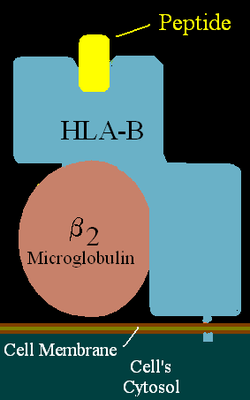HLA-B75
Further information: HLA-serotype tutorial
 | ||
| HLA-B (alpha)-β2MG with bound peptide | ||
| major histocompatibility complex (human), class I, B75 | ||
| Alleles | B*1513 | |
| Structure (See HLA-B) | ||
| Shared data | ||
| Locus | chr.6 6p21.31 | |
HLA-B75 (B75) is an HLA-B serotype. The serotype identifies certain B*15 gene-allele protein products of HLA-B.[1]
B75 is one of many split antigens of the broad antigen, B15. B75 (B*1502) is associated with a severe drug-induced skin condition in ethnic East Asians.[2]
Serotype
| B*15 | B15 | B62 | B63 | B70 | B71 | B72 | B75 | B76 | B77 | Sample |
| allele | % | % | % | % | % | % | % | % | % | size (N) |
| *1502 | 7 | 22 | 62 | 1035 | ||||||
| *1521 | 7 | 12 | 55 | 132 | ||||||
| Alleles link-out to IMGT/HLA Database at EBI | ||||||||||
Alleles
| freq | ||
| ref. | Population | (%) |
| [4] | Philippines Ivatan | 22.0 |
| Taiwan Puyuma | 18.0 | |
| China Guangxi Maonan | 14.8 | |
| China Yunnan Lisu | 12.3 | |
| Taiwan Tao | 12.0 | |
| Singapore Chinese Han | 11.6 | |
| China Guangzhou | 11.0 | |
| Hong Kong Chinese | 10.2 | |
| China Yunnan Nu | 9.0 | |
| Singapore Riau Malay | 8.4 | |
| Singapore Javanese Indonesians | 8.2 | |
| Thailand (3) | 8.2 | |
| China South Han | 7.1 | |
| Singapore Thai | 6.1 | |
| India Khandesh Pawra | 6.0 | |
| Taiwan Minnan pop 1 | 5.9 | |
| Singapore Chinese | 5.7 | |
| India West Bhils | 4.0 | |
| Taiwan Pazeh | 3.6 | |
| China Guangdong Meizhou Han | 3.5 | |
| South Africa Natal Tamil | 3.1 | |
| China Qinghai Hui | 2.7 | |
| Taiwan Hakka | 2.7 | |
| Shijiazhuang Tianjian Han | 2.4 | |
| China North Han | 1.9 | |
| India Mumbai Marathas | 1.9 | |
| India North Delhi | 1.6 | |
| China Beijing | 1.5 | |
| China Inner Mongolia | 1.5 | |
| American Samoa | 1.0 | |
| India North Hindus | 1.0 | |
| Taiwan Siraya | 1.0 | |
| Taiwan Tsou | 1.0 | |
| Ingig. Australian Groote Eylandt | 0.7 | |
| United Arab Emirates | 0.6 |
| freq | ||
| ref. | Population | (%) |
| [4] | Indig. Australian Cape York Penin. | 13.5 |
| Indig. Australian Yuendumu | 12.4 | |
| PNG Eastern Highlands Goroka | 7.1 | |
| Ind. Australian Groote Eylandt | 6.0 | |
| New Caledonia | 5.8 | |
| Singapore Riau Malay | 4.0 | |
| American Samoa | 3.0 | |
| Australian Aborigine Kimberly | 2.6 | |
| PNG Karimui Plateau | 2.5 | |
| Singapore Javanese Indonesians | 2.0 | |
| Papua New Guinea Wanigela | 1.5 | |
| USA Asian | 1.4 | |
| Philippines Ivatan | 1.0 | |
| Thailand (3) | 1.0 | |
| Taiwan Hakka | 0.9 |
Diseases
HLA-B*1502 is associated with Carbamazepine and phenytoin induced Stevens–Johnson syndrome in Chinese and Thai.[2][5][6] One study showed a 100% association between B*1502 and the drug induced skin disorder in Chinese.[5] In Europe the B*1502 positive patients are only found in this syndrome of persons of East Asian descent, however B58 confers susceptibility to both groups but to a lesser degree and is sensitive to allopurinol.
References
- ↑ Marsh SG, Albert ED, Bodmer WF, et al. (2005). "Nomenclature for factors of the HLA system, 2004". Tissue Antigens. 65 (4): 301–69. doi:10.1111/j.1399-0039.2005.00379.x. PMID 15787720.
- 1 2 Chung WH, Hung SI, Hong HS, et al. (April 2004). "Medical genetics: a marker for Stevens–Johnson syndrome". Nature. 428 (6982): 486. doi:10.1038/428486a. PMID 15057820.
- ↑ derived from IMGT/HLA
- 1 2 Middleton D, Menchaca L, Rood H, Komerofsky R (2003). "New allele frequency database: http://www.allelefrequencies.net". Tissue Antigens. 61 (5): 403–7. doi:10.1034/j.1399-0039.2003.00062.x. PMID 12753660. External link in
|title=(help) - 1 2 Locharernkul C, Loplumlert J, Limotai C, et al. (July 2008). "Carbamazepine and phenytoin induced Stevens–Johnson syndrome is associated with HLA-B*1502 allele in Thai population". Epilepsia. 49 (12): 2087–91. doi:10.1111/j.1528-1167.2008.01719.x. PMID 18637831.
- ↑ Man CB, Kwan P, Baum L, et al. (May 2007). "Association between HLA-B*1502 allele and antiepileptic drug-induced cutaneous reactions in Han Chinese". Epilepsia. 48 (5): 1015–8. doi:10.1111/j.1528-1167.2007.01022.x. PMID 17509004.
This article is issued from Wikipedia - version of the 5/31/2016. The text is available under the Creative Commons Attribution/Share Alike but additional terms may apply for the media files.